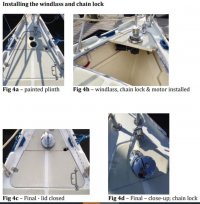Hi Leon,
My entire reason for installing an electric windlass was exactly the same as yours - so I can safely single-hand the boat, including operation of the windlass from the helm.
The main two reasons I took out the anchor well liner were that:
(i) I wanted maximum volume inside the well for stowing the chain, a lot of nylon rode, and perhaps the anchor for long passages, and
(ii) I needed access to the V-berth bulkhead, so I could reinforce it, because I was also installing an inner forestay which needed to be terminated in that bulkhead. (see my separate thread on the Ericson forum about that project)
A 3rd benefit I saw in removing the shell was to give me access to the nuts that secure the bow cleats and the stemhead fitting, and for access to the wiring for the running lights mounted on the pulpit.
The windlass platform is very tight - in addition to the wings, which are only just touching under the deck, you'll see that the aft pair of mounting bolts for the chain stopper go through the lid and the forward pair are through the deck: this really keeps the lid in place.
If you do this installation without removing the shell, and you want a chain stopper mounted as I did (straddling the gap between the forward edge of the lid and the foredeck), you could just make a small cut-out in the shell just big enough for (i) your hand to screw nuts onto the forward mounting bolts for the chain stopper, and (i) to use a wrench to tighten them. don't drop the wrench ;-)
I did the 'wings' thing so I could get away with just caulking the lid closed - so I could pull it out if I ever need to access the bow cleats, stem head fitting, etc.
You could definitely install a windlass with the OEM anchor well liner remaining in place (and it's little drain line in the bottom). That would save you a TON of time and effort!!
I imagined that the windlass would try to lift up and pull forward the portion of the lid into which it was mounted when under load with the anchor/rode. Give that possibility some thought for your installation if you don't want to epoxy that portion of the lid in place.
You can probably just install an ss right-angle strap on each side: glue and screw one leg to the liner and screw up into (not through) the lid to secure the other leg of the strap: this'll probably hold the lid down when the windlass pulls up the anchor.
You will definitely want to reinforce the portion of the lid that carries the windlass. Read about how I did that - including extending the reinforcement ~1" to the forward edge of the aft, hinged, part of the lid.
Also - think about a chain-stopper (you never want to leave the anchor rode under tension on the drum of the windlass for any length of time). Instead of a chain-stopper, you could just be sure to always use a pair of snubbers, secured to the bow cleats, to take the weight off the windlass while at anchor, and also use some way to secure the anchor when it's in the bow roller so it's not pulling directly on the windlass when you're under way.
Finally, think about the max length that the anchor shaft can be, before it comes back too far and interferes with the chain stopper or the windlass - for this consideration, I was restricted to short-shaft anchors (the Vulcan works perfectly for me). I briefly considered have a 6" extension fabricate for the bow roller, but realized that would be an engineering feat, given the forces that are on the bow roller.
Cheers!


